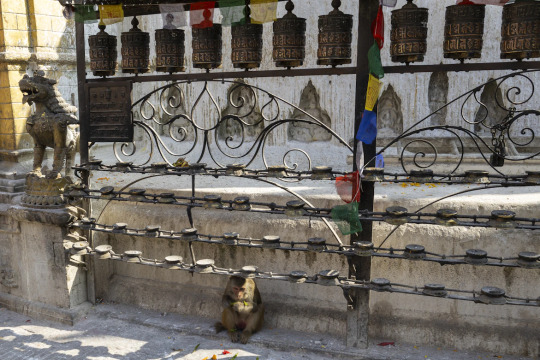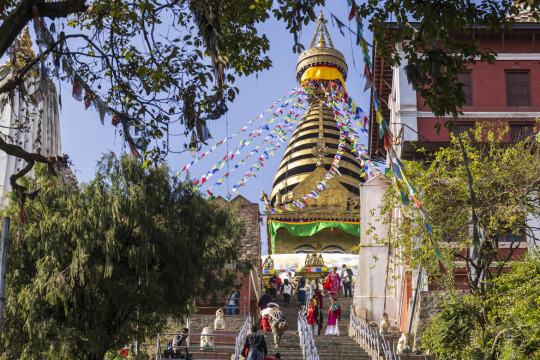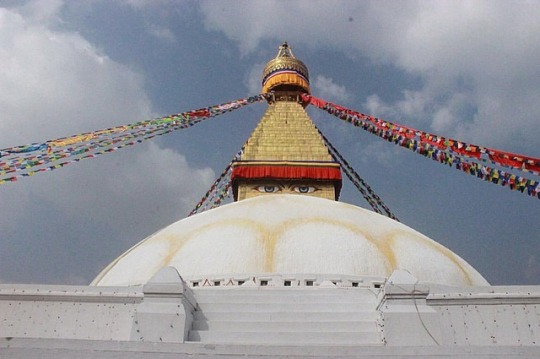#mahachaitya
Explore tagged Tumblr posts
Text





Swayambhunath, Kathmandu, Nepal
Martijn Vonk
0 notes
Text

Farmland and countryside of Kathmandu valley - from the ‘Swayambhu Mahachaitya’ (religious temple) - atop a hill, west of Kathmandu city, Kingdom of Nepal, c. 1863. [800 x 742] https://ift.tt/V76DmRF https://ift.tt/V76DmRF Submitted October 09, 2024 at 04:30AM by BostonLesbian https://ift.tt/k7t8NbB via /r/HistoryPorn
0 notes
Photo

खस्ती महाचैत्य, Khasti Maha Chaitya - बौधनाथ #nepal #kathmandu #bauddhanath #buddhism #khasti #mahachaitya #newa #newacivilization #savenepavalley #travel #ghumau_nepal #travelnepal #heritage #worldheritage #himalayan (at Baudha, Nepal)
#worldheritage#heritage#mahachaitya#buddhism#savenepavalley#ghumau_nepal#bauddhanath#newacivilization#travel#kathmandu#khasti#himalayan#nepal#newa#travelnepal
1 note
·
View note
Text
Architecture (Part 15): Indian Stupas
The earliest Indian architecture that survives today was built by the Buddhists, a religious sect founded in the 600's BC. Their main building was the stupa, which was originally a burial mound. But after the cremated remains of Buddha (d.483 BC) and his disciples were placed in them, the stupas became relic shrines, commemorating Buddha & this teachings. They were the main focus of worship until the Buddha idol.
Stupas were also built to honour sacred sites & events. The stambha or lath was a free-standing monumental column, often associated with a stupa. One or two of was close to every great stupa, and in front of important chaitya halls.
The basic part of a stupa is the anda (literally “egg”) – the half-dome. On top of it is a small platform, usually with a railing, called the harmika (or tee). Above the harmika is the yasti (pole), which supported umbrella-shaped tiers called chatras.

Most early stupas were undecorated, but there is evidence that later ones were elaborately decorated, especially from the 100's & 200's AD. Below is a drawing of the original Amaravathi Mahachaitya (now in ruins), based on inscriptions at Masulipatam. It was covered in stucco, and ornamented with medallions, wreaths, and scenes from Buddha's life.


Ruins.
Worship was performed by carrying out pradakshina – walking clockwise around the stupa. This was done on a paved pathway, which was enclosed by vedika (railings).
The vedika were often broken at the cardinal compass points by toranas – gateways made of two posts linked by architraves (a moulding on top, extending over the posts). They were often elaborately sculpted. Worshippers contemplated the imagery on the toranas, and thus entered the state of mind necessary for pradakshina.

Torana in Sanchi.
The vedika were important elements themselves, defining the boundary of the sacred area. They were often decorated, usually with medallions carved with animals, birds, flowers and mythological figures.

Vedika.
The earliest-surviving stambhas were build by King Asoka (c.269 – 232 BC), and may have been based on earlier wooden models. They were inscribed with religious doctrines and historical information.
Above the stambha's ornamental necking was the capital, many of the Persian type (specifically Persepolitan). Other Persian/Assyrian influence can be seen in honeysuckle decorations, for example on the base of the Sankassa Elephant.

Lion capital of Ashoka.

Sankassa Elephant.
Stambhas were still built into the 1600's & 1700's. The Jains (followers of Jainism, another Indian religion) especially liked them, and they built them in front of their temples. Below is a manastambha (“column of honour”) with a small pavilion on its capital.

The Hindus also built stambhas, as lamp-bearing pillars, or Deep Jhyoti Stambhs.

Deep Stambh at Mahuli.

7-storied lamp tower at Mangueshi Temple.
#book: a concise history of architectural styles#history#architecture#buddhism#jainism#hinduism#india#ancient india#stupa#stambha#manastambha#deep jyoti stambh#amaravathi mahachaitya#mangueshi temple
3 notes
·
View notes
Photo

Swayambhu Mahachaitya Paubha, Nepal
44 notes
·
View notes
Text










10/19 (Part II)
After our Everest flight we had a quick breakfast and then took a tour of northern Kathmandu. One of our guides is from a farming village in the mountains, and he brought an organic red delicious apple for us to try. It tasted great! So much better than the bland red delicious that are grown in the U.S.
Temples, temples, temples... We have seen so many temples in the last two months! We first went to Pashupatinath, the Temple of the Lord of the Living. It is an extremely important temple to Hindus. We saw many strange things... Families washing their recently deceased in the holy (but quite polluted) river, public cremation sites, noisy families of macaques (monkeys), holy men (sadhus) with painted faces, and wild cows roaming the walkways. It's really a different world here.
Then we drove to a hilltop to see the "Monkey Temple," a Buddhist temple called Swayambhu Mahachaitya. There we saw even more monkeys! And a great view over the city as well.
We ended at the Kathmandu Durbar Square, which was crowded and crazy. The Dashain festival is still ongoing, and it felt like being in Rockefeller Center at Christmas! There were lines hundreds of people long, waiting to enter special temples and see people who are believed to embody Hindu gods. Unfortunately most of the temples were destroyed in a massive earthquake in 2015, but we saw enough to feel a sense of wonder at this world heritage site. Some of the buildings have been standing for over 1,500 years!
Today we leave the city and head for the Himalayas. We will stop at a few smaller, touristy cities first (Bandipur and Pokhara), and after that we will begin our 7-day trek in the South Annapurna mountains!! Wifi might not be available, so we will be sure to update everyone when we finish the trek.
Namaste 🙏
2 notes
·
View notes
Photo

Swayambhunath (Monkey Temple): Swayambhunath stupa complex that sits atop a high hill overlooking Kathmandu and the entire Kathmandu Valley with Mountain ranges on the north side. Swayambhunath is probably the most sacred Buddhist pilgrimage site in Nepal. It is another famous tourist destination and the holiest Buddhist and Hindu pilgrims. This temple also called the Monkey temple due to the lots of monkeys and they have their swimming pool. This is a wonderful place to catch your breath and observe the sunset, start to understand the deep importance of Buddhist belief to the people. It consists of a huge white stupa with the all-seeing-eyes, it believes in the love and peace of Lord Buddha, and many small stupas and beautifully carved stone shrines on the top of the hill. If you feel more energetic then you might also like to try some or all of the 350 steps or more that lead all the way from the eastern part from the temple called Bhagwan pau (God Feet)up to your Swayambhunath stupa vantage point. (at Swoyambhu Mahachaitya) https://www.instagram.com/p/CSDgQTcllEr/?utm_medium=tumblr
0 notes
Text
Top Six Buddhist Stupas/Mahachaityas in Kathmandu
Top Six Buddhist Stupas/Mahachaityas in Kathmandu
Thank you for reading my blog. Hope you enjoyed the video. Please view my other videos at Umakant’s Youtube or at Soubhagya’s Youtube channel. If you like my videos then please subscribe to the YouTube channel.
youtube
View On WordPress
0 notes
Photo

No Caption (at Swoyambhu Mahachaitya) https://www.instagram.com/p/CJtZWbCjGJa/?igshid=todkdilanuvl
0 notes
Photo


Adoration of the Buddha Begging Bowl The great stupa or Mahachaitya at Amaravati, Andhra Pradesh, India Drawing by Henry Hamilton of a carved limestone medallion unearthed at Amaravati in 1817. The Amaravati Stupa was founded in the 3rd-2nd centuries BC and enlarged in the 1st-4th centuries AD under the Satavahana and Ikshvaku patronage and represents one of the greatest architectural achievement of ancient India. In the 19th century a series of excavations took place at the site. In 1880 the Governor of Madras, the Duke of Buckingham, gave the order to J.G. Horsfall to 'clear' the site. In this way the site turned into a large pit with the excavated sculpture arranged around it. The monument now only survives in the collections of the Amaravati sculptures kept in various museums. (via Rare Book Society of India)
49 notes
·
View notes
Photo

Bavikonda is an important Buddhist heritage site located 15 km, northeast from Visakhapatnam city. The Hinayana school of Buddhism was practised at the monastery between the 3rd century B.C. and the 3rd century A.D. Bavikonda has remains of an entire Buddhist complex, comprising 26 structures. A piece of bone stored in an urn recovered here is believed to belong to the mortal remains of the Buddha. The word Bavikonda in Telugu means "a hill of wells". Fitting its name, Bavikonda is a hill with wells for the collection of rainwater. Excavation carried out from 1982 to 1987 revealed a Buddhist establishment including a mahachaitya embedded with relic caskets, a large vihara complex, numerous votive stupas (shown below), a stone-pillared congregation and rectangular halls and a refectory. #FollowADifferentPath #crookedcompass #dream #explore #discover #wanderlust #bucketlist #travel #traveller #traveler
#traveller#dream#wanderlust#explore#followadifferentpath#traveler#bucketlist#discover#travel#crookedcompass
1 note
·
View note
Photo

#Swayambhu😍 (at Swayambhu Mahachaitya स्वयम्भू माहाचैत्य - Syangun स्यङ्गुँ) https://www.instagram.com/p/B62jFlFnPgg/?igshid=1m8t8ym13wqtg
0 notes
Photo

Swoyembhunath : temple des singes est l’un des plus anciens et le plus saint des sites boudhistes situé sur les hauteurs de Katmandou. . . . . . . . . #swayambhunath #boudhisme #boudhiste #temple #katmandou #voyage #exploretheworld #frenchvoyageurs #nepal #neverstopexploring (à Swayambhu Mahachaitya स्वयम्भू माहाचैत्य - Syangun स्यङ्गुँ) https://www.instagram.com/p/B6vIY7PIJBI/?igshid=ecq99mdkewj5
#swayambhunath#boudhisme#boudhiste#temple#katmandou#voyage#exploretheworld#frenchvoyageurs#nepal#neverstopexploring
0 notes
Photo

Don't be the man of success ✊ Be the man of value👊 (at Swayambhu Mahachaitya स्वयम्भू माहाचैत्य - Syangun स्यङ्गुँ) https://www.instagram.com/p/B5scu9VhyFA/?igshid=13xeeu02ionn9
0 notes
Photo

Chal beta selfie le le re 📸 #swayambhu #temple #kathmanduview #family #sdltraveldiary #lifeisbeautiful (at Swayambhu Mahachaitya स्वयम्भू माहाचैत्य - Syangun स्यङ्गुँ) https://www.instagram.com/p/B5Xkz6aFUn1d9xsDefFX1D74YFfW7vyDOJwcG40/?igshid=ejhvtgz71p7e
0 notes
